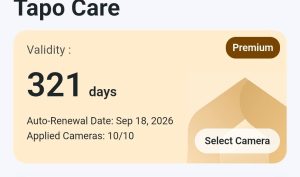 TP-Link’s Tapo is one of the few home security camera companies to offer three different ways to store video archives. It’s not an easy decision to make given the complexity of the Tapo Care vs Tapo Hub vs Micro SD Card topic. Making the decision more difficult is the availability of three different hubs and three different Tapo Care Plans all of which have their own limitations.
TP-Link’s Tapo is one of the few home security camera companies to offer three different ways to store video archives. It’s not an easy decision to make given the complexity of the Tapo Care vs Tapo Hub vs Micro SD Card topic. Making the decision more difficult is the availability of three different hubs and three different Tapo Care Plans all of which have their own limitations.
We have previously looked at several Tapo home security cameras including the Tapo C210 2K Pan and Tilt and Tapo C101 1080P Indoor Security Camera.
Video Recording Overview
We’re looking at the three options for video event recording.
The least expensive will be a Micro SD Card. The initial outlay of a small amount of money for the card is all it will cost. Your storage is limited by the size of the card. The cameras can be set to overwrite what is written when the card fills. This is also known as local storage. In a way it’s the most private since the data resides on the card you own versus the Tapo Care option.
Taking local storage to a higher level, Tapo Hub offers an aggregated repository for video events from multiple devices. It adds complexity versus the local storage option just discussed but might be a cost effective means for multiple cameras. This option also unlocks features on some cameras such as facial recognition. Some hubs can be greatly expanded by adding a drive.
Lastly, Tapo Care is a cloud based storage service. Unlike the prior two options discussed, Tapo Care is paid via an annual subscription that will vary depending upon the number of cameras connected.
Local Storage
Local storage is added to a Tapo camera using a Micro SD Card. After inserting the card, you will format it through the app. Choose a size based upon the amount of data you want to retain prior to overwrite. Personal experience is that 64GB is the minimum size. Also ensure the card is rated sufficiently for recording video.
We have a detailed overview on selecting the right Micro SD Card that is worth checking out.
Tapo Hub
The Tapo Hub can control multiple devices including up to 16 cameras. There are several different models of hubs on the market with the Tapo H500 being the largest and most advanced. Connection of most Tapo cameras to the H500 will enable several features but most importantly, the addition of a SATA drive can dramatically extend the storage removing the need to purchase SD cards or subscribe to Tapo Care.
The H500 can be used for a lot of other things besides video storage. Mostly around integration of Tapo sensors.
There are several other models of Tapo Hub but with greatly reduced connectivity capabilities and not worth the investment in our opinion.
Tapo Care
This is a cloud based storage solution administered by Tapo. This service stores your video in a data center. A free 30-day trial comes with most Tapo cameras. After 30 days, it can be renewed at additional cost.
Tapo Care provides 30 days storage with videos older than 30 days rolling off.
The current pricing for Tapo Care is either $3.49 per camera per month or $32.99 per year. You can also select a “mega” plan which supports up to 10 cameras for $11.29 monthly or $112.99 yearly.
The most significant advantage to Tapo Care is that nobody can steal your cloud storage. If you are using an SD Card or a hub, someone can steal these devices along with the archived video. In the case of cloud storage, there isn’t anything present to steal.
It’s easiest to sign up directly through the app.
Which Option is Best?
It depends how much you want to spend and if you’re comfortable with your video events being stored in the cloud. In our opinion, Tapo Cloud is the superior option of the three because it’s the most secure in case of device theft. An SD card is our second favorite option. WOrks well albeit a little slower than Tapo Cloud. The hub is a distant third place, especially if only being used for video archive.
